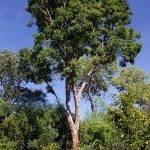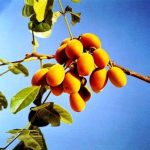TREE LIFE
June 1998
MASHONALAND CALENDAR
Saturday 6th June. Botanic Garden Walk. This month Tom concludes the series on the lowveld trees. We will meet Tom in the car park at 10.45 for 11 a.m. – There will be a guard for the cars.
Sunday 21st June. Venue: – Devonia Farm Enterprise Area. Liz and Dennis Lapham have very kindly offered us this venue for June and after exploring the kopjie which has quite a number of tree species in its surrounds we will proceed to the farm house to look at their wonderful garden where we will have our lunch. For those who are interested, Dennis will show a video on their visit to China for the World Cycad Congress last year. Bring lunch and meet at 9.30a.m.
Saturday 7th June. Please phone Mark Hyde at home on 745263 for this month’s venue and time.
Saturday 4th July. Botanic Garden Walk.
MATABELELAND CALENDAR
Sunday 7th June. ALL DAY visit to Matopos – Zindele Safaris, Shumba Shaba Lodge. This site is situated near the top of a granite hill and has a breathtaking view – don’t miss it. Bring lunch and liquid refreshments. Distance from Bulawayo is approximately 50km. Meet at Girls’ College at 8 a.m. for departure soon after.
Wednesday 10th June. The last episode of The Private Life of Plants at Girls’ College at 7.30 for 8 p.m. Please use the Pauling Road entrance where the security guard will admit your car.
A Note of interest.
Accompanying an interesting article about Tackie Bannerman’s wanderings around Northern Malawi – (to appear in Tree Life shortly) is this paragraph.
“Re coffee escaping into the forests – Tree Life October 1997, as far as I am aware it is all over the lower forests in the Eastern Highlands.
It does not really appear to be a problem, however. Funnily enough it remains very healthy though it produces very little fruit – no stress I think.”
BOTANIC GARDEN WALK: 2 May 1998
Evidently the change to a Saturday morning caught a number of members unaware and with a smaller party than usual, Tom continued further with lowveld trees, which included a number of lesser-known and unusual species.
Possibly one of the most attractive of our indigenous Terminalia species would be Terminalia sambesiaca. It is worth noting as it has a smooth bark unlike the other members of the family and grows into a large tree with typical horizontal branching and small green leaves which are slightly hairy and are clustered at the terminal growth of branches. Typical habitats are riverine and granite kopjies and this species would have good potential for a large garden.
A shrub came next displaying attractive red tinted foliage and with some surprise we noted that this is of the coffee family, Coffea zanguebariae, having been a surprise find by Kim Damstra in the vicinity of the Sapi River mouth west of Mana Pools on its favoured habitat of alluvium. Some other features worth noting are the obovate and decussate green leaves that have bright yellow veins and a well defined attenuate tip.
Manilkara concolor is a species that is new to me and occurs generally as an erect shrub. The new growth is rusty coloured and small stiff, grey green leaves produce a minute quantity of white sap from the broken stalk. The small white flowers deserve some comment as they droop down supported on a long slender corolla. On closer examination it appears that the anthers and stigma are grouped together to form a conical structure. A species more commonly found in Mozambique but some are found in this country near Chiredzi.
A tree of rather spiky appearance as its branches are almost horizontal as well as the branchlets being produced in three’s is
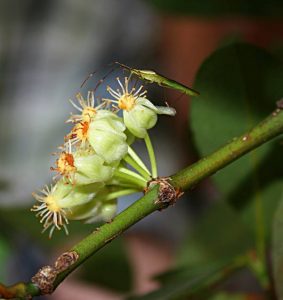
Garcinia livingstonei. Photo: Mark Hyde. Source: Flora of Zimbabwe
Garcinia livingstonei. This is a common inhabitant of all major lowveld river systems and also in granite hills at low altitudes and its unusual shape makes the tree reasonably easy to identify.
Onto the spiny plants with Citropsis daweana, which is often a constituent of dense dry layered forest. Some of the main distinguishing features are the strong straight spines scattered along the new branches and the small compound leaves, which have a well defined winged rachis and surprisingly hairy alternate leaflets. A lemon-like scent is produced from the leaves, if damaged, by the fluid released from the many tiny pellucid glands, this being a typical feature of the Rutaceae family.
Dovyalis hispidula is another spiny species, which is of the Flacourtiaceae family. These spines are long and slender protecting the small rounded shiny green leaves. A yellow fruit is produced and according to Tom is edible. There were, however, no fruits available to test this information!
The well-known Potato creeper, Phyllanthus reticulatus, is a spreading creeper with alternate leaves cunningly placed so the leaf appears to be compound. The common name is derived from odour produced by the clusters of tiny flowers during late afternoon and early evening. A common species throughout low altitudes.
Lecaniodiscus fraxinifolius, better known as the River Litchi, is a riverine species that generally remains as a large untidy shrub or small tree. Thin wavy leaflets, which often have a moth eaten appearance, turn an attractive red colour in autumn.
Ziziphus pubescens was a new one for most us and presented a few challenges. Firstly the leaf although looking typical of the species is much smaller than its more common relatives and there is none of the expected forward and backward curved hooks, only lateral spurs formed from modified branchlets. This particular specimen came from a tributary of the Angwa River near Kanyemba. Other areas include the Beitbridge district and the Shashi district and are generally riverine in habit.
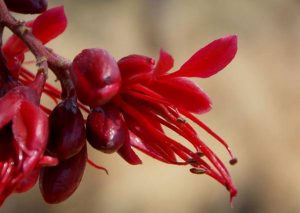
Schotia brachypetala. Photo: P.English. Source: Flora of Zimbabwe
Schotia brachypetala, well known by it common name of ‘weeping boerboom’ is common in low altitudes especially on anthills where a higher alkalinity exists. Clusters of bright red flowers are produced which drip nectar and is very attractive in flower. A worthwhile garden subject if a termite mound is available!
The jackal berry, Diospyros mespiliformis, is another of the well-known lowveld trees growing to substantial size in ideal habits such as riverine. Apart from the wavy glossy green leaves grouped towards the end of the branchlets, a persistent calyx at he base of the fruit identifies the family immediately and there is also an apical bud produced at an angle. The fruit are prized by monkeys and as the common name suggests, jackals. Is this fact or fiction?
The Waterberry is a common highveld species but a subspecies with a distinctive pale grey smooth bark is found particularly in the Victoria Falls area and up the Hunyani system. This is Syzygium guineense subsp. barotsense, which has a rather droopy effect from the long leaf. A larger fruit compared to the other Syzygium species is produced.
Drypetes mossambicensis can become a very large tree under favourable conditions and forms dense foliage. The leaves have an asymmetric base and are deep green with pale underside. The trunk is pale grey.
To finish we looked at two more climbers; the better known being Artabotrys brachypetalus, where the remains of the inflorescence turn into the grapple hook to assist with supporting the unwieldy branches. Large simple leaves are produced. The other discussed was Dalbergia arbutifolia where the branchlets form into tendrils and small simple pinnate leaves with a crinkly texture are on obvious feature.
A most interesting walk and our thanks to Tom for leading once again.
-A. MacNaughtan
NEW YEAR’S GIFT: 10 APRIL 1998
Our first full day in the Tanganda River valley and we were just setting off when Linda and the boys arrived from Harare having set off very early in the morning. While turning the Landcruiser, Linda put a wheel into an unexpected culvert and had to be pulled out by Miles.
With the guidance of Michael Brown, we then set off to a part of the Tanganda River, near to Buffels Drift Farm. The object was to label some of the trees in the riverine vegetation. The altitude is 760 metres, which is fairly low and the atmosphere was moist and steamy. The Tanganda River, hidden away in the riverine vegetation, was flowing strongly.
Labelling was well organised. Maureen had prepared a key that converted a species name to a number. I carried the labels and wrote the national tree number on the label with a felt tip and Miles had the hard work of actually nailing the label to the tree.
A common species of tree was Trichilia (probably Trichilia emetica) with its characteristic dark green, imparipinnate leaves. Also common was Khaya anthotheca, which of course has paripinnate leaves. It also has winged seeds arranged characteristically in the fruit and a number of these were found on the ground.
One of the most interesting features of the Tanganda River valley is the escaped Albizia procera, which as far as I know is not naturalised anywhere else in Zimbabwe. It occurs in profusion in the riverine vegetation and has graceful large 2-pinnate leaves –generally too large to be pressed within a single sheet of newspaper. The usual Albizia-like gland is present on the petiole but is exceptionally large and is hollowed out so that it somewhat resembles a human mouth. The attractiveness of the foliage is remarkable – is this a case of being an alien and therefore having no Zimbabwean predators?
Other native riverine trees seen were
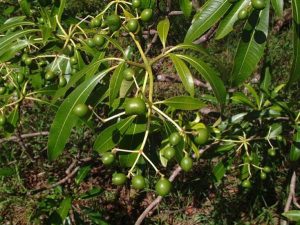
Rauvolfia caffra. Photo: R. Burrett. Source: Flora of Zimbabwe
Rauvolfia caffra, Kigelia africana, the beautiful red flowers of Bauhinia galpinii, Maesa lanceolata and (cleverly recognised by Maureen) the gland-dotted compound leaves of Fagaropsis angolensis.
The vegetation also had a very high weed content. Apart from the Albizia procera, we saw numerous bushes of Guava (Psidium guajava), Mauritius Thorn (Caesalpinia decapetala), Solanum seaforthianum, and Castor-oil plant (Ricinus communis).
Two tree species from the family Apocynaceae were found. Both produce milky latex and have opposite leaves. They were the Toad Tree (Tabernaemontana elegans), complete with magnifi¬cent paired “toads” and Holarrhena pubescens.
Altogether, an interesting start to our weekend, the only disappointment being – no Deinbollia!
-Mark Hyde
CRYSTAL CREEK Saturday, 11 April 1998
Once again we started fairly late after a slap up breakfast, but the drive to the Crystal Creek valley was accomplished without any stops. Unfortunately we did not recognise the turnoff to the crossing, which had been washed away and is now overgrown. We turned the cars and on the way back spotted a newer road down to the creek where we parked the cars. This spot seems to have become very popular as 4 other cars actually crossed the river to picnic at the waterfall.
The general feel of the area was very damp with lots of orchids, ferns and unidentified Rubiaceae together with the sound of running water. Guavas and lemons are also encroaching. There was so much to see that the party split into individuals who did what they wanted when they wanted.
The first tree to confront me was large with leaves in whorls and I was very pleased that I remembered from the previous day that Rauvolfia makes milk and has a dark fringe of hairs at the base of the leaf stalk while Breonadia does not. These specimens were confirmed by the pros as Breonadia and in fact we saw no Rauvolfia during the day. (As we left New Year’s Gift we confirmed that the bark of Rauvolfia is finely fissured while that of Breonadia is very coarsely broken).
The brown terminal leaflets (praying hands) of Harungana madagascariensis were confirmed by the orange milk that it produced, while the winged rachis of Bersama abyssinica caught my eye. The red bulbous fruits confirmed the hairy and shiny alternate leaved
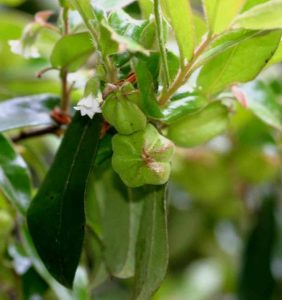
Diospyros whyteana. Photo: BT Wursten. Source: Flora of Zimbabwe.
Diospyros whyteana. I was very pleased to find that the hairy leaves of the Vangueria were very thin and floppy indicating that this was the eastern districts specialty Vangueria esculenta (others also saw Vangueria apiculata and Vangueria infausta).
Looking up into the trees we saw the mistletoe fingers and white berries of Zimbabwe’s only cactus – Rhipsalis baccifera. My thanks to Pat Ogilvie who took time to show me the grass-like pendulous leaves of Polystachya vaginata, which were growing in abundance, and the beautiful white racemes of Ypsilopus Iongifolius.
We all lunched together on the side of the creek and then split again and this time Mark, Robert and Andrew and l wandered up to see the waterfall. Highlights of this walk were the Royal Fern (Osmunda regalis) along the river with the fruiting head of the frond showing itself very distinctively; Anemia simii raising its two fertile pinnae above the frond attracted attention and the numerous beautiful orange fruit of the prickly trifoliate leafed Toddalia asiatica (which I wrapped in the thick leaves of Annona senegalensis).
When asked what else should be mentioned in the write up Maureen and Mark showered me with names, but were very excited by Bridelia micrantha, Catha edulis, Dodonaea angustifolia, Faurea saligna, Heteropyxis dehniae, Ilex mitis, Maesa lanceolata, Pittosporum viridiflorum, Rhus chirindensis, Sapium ellipticum,
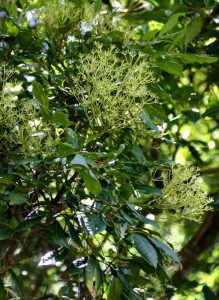
Schefflera umbellifera. Photo: BT Wursten. Source: Flora of Zimbabwe.
Schefflera umbellifera and Trimeria grandifolia. A few unidentified specimens did however find their way into the presses at the end of the day including a purple Dissotis with yellow ‘stockings’ which, like Shakespeare’s Malvolia, I feel should have been cross gartered.
Robert and Andrew loved the time that they spent paddling/swimming in the creek while this write up should say for itself “I had a fantastic day” – and I did enjoy the bath when we got home.
-Linda Hyde
CHIRINDA FOREST AND ESPUNGABERA: Sunday April 12th 1998
On Sunday morning, we set off in three vehicles to travel the 60km from New Year’s Gift to the well-known Chirinda Forest. One of the pleasures of visiting Chirinda is the excellent Visitor’s Guide, edited by our own Jonathan Timberlake with Phil Shaw. This contains, apart from details of the forest’s history and physical features, information about the trees by Blake Goldsmith and a complete list of plant species compiled by Bob Drummond and Isaac Mapaure.
The forest lies 30km SE of Chipinge and covers two hills above an altitude of 1100m rising to 1240m at its highest point. It is the southernmost tropical rainforest in Africa and is classified as medium-altitude forest. The woody vegetation of the forest has its strongest links with the Afromontane zone (that is the chain of mountains running down the eastern side of Africa from the Ethiopian Highlands to the Cape) and the Zanzibar-Inhambane zone (East African coastal forests).
Although a number of species occur in Zimbabwe only at Chirinda (for example, Strychnos mellodora), very few species are truly endemic on a worldwide basis. One that is, is a tree, (Neopalissya) Necepsia castaneifolia, which has its own endemic subspecies, subsp. chirindica. Other subspecies of this tree occur in Tanzania and Madagascar.
Arriving at the forest, where for the first time in my experience we were charged an entrance fee, we parked in the car park. The main party then set off for the Big Tree and from there walked round in a circle finally coming up the ‘Valley of the Giants. Meanwhile, Maureen and I walked slowly down into the Valley of the Giants looking carefully at every plant and trying to name it. The others were much amused to find that we had covered only about 100 metres – even slower than the usual Tree Society pace.
One common tree in the forest, which is rare elsewhere, is the Brown Mahogany, Lovoa swynnertonii. It belongs to the family Meliaceae and with its large glossy compound leaves it is somewhat like
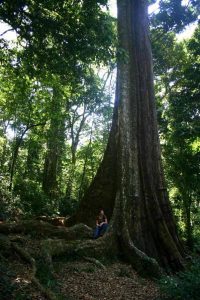
Khaya anthotheca. Photo: BT Wursten. Source: Flora of Zimbabwe.
Khaya anthotheca (the Big Tree is of course Khaya). Lovoa shares with Khaya (and Entandrophragma from the same family) the feature of paripinnate leaves (that is with an equal number of leaflets on each side of the rachis, or to put it another way, with no terminal leaflet). This is not a common feature in Zimbabwean plants outside the Leguminosae subfamily Caesalpinioideae.
A very common shrub in the understorey is Argomuellera macrophylla. This belongs to the Euphorbiaceae. It has largish chestnut (Castanea)-like leaves that tend to be crowded at the ends of the branches and from these clusters arise the flowers in long racemes.
Another interesting find was Didymosalpinx norae (originally named Gardenia norae after Swynnerton’s wife, Nora). I have never forgotten the amusing variations on this name coined by Ian McCausland on an earlier visit. The tree was covered in small stripy fruits and was spiny, a feature, I must admit I had forgotten.
Necepsia castaneifolia, as mentioned before, was seen by the other party. It is said to resemble a thorn-less lemon. Its flowers are in spikes and look a bit like Argomuellera, to which it is related. One little spot-character is that the petiole is thickened into the leaf lamina.
Very common in the forest was Trilepisium madagascariense. This is from the fig family, Moraceae, and produces milky latex when a leaf is broken off. The leaves are dark green and have a short but noticeable acuminate tip.
Apart from the trees, we also looked at a remarkable broad-leaved forest grass that occurs commonly in the shade by the footpaths.
Its name was Leptaspis cochleata (now Leptaspis zeylanica), the specific name referring to the shell-like spikelets.
Another beautiful herb is Geophila repens, a tiny creeping herb with white flowers and red berries. It is an herbaceous Rubiaceae and occurs commonly by the paths in the forest.
After lunch back in the car park, we drove back to the main road and from there took the turn to Espungabera on the border with Mozambique. The drive took us through the forest at first and then into more open rolling cultivated country with patches of forest running along the streams. At the border we turned round in the car park and back at Mount Selinda stopped again amongst some gigantic trees in the Chirinda Forest. Here we saw another very rare tree in the Euphorbiaceae, namely Tannodia swynnertonii. This also has flowers in long spikes and the typical glossy dark green leaves of so many forest species.
We then drove to the site of Swynnerton’s house in the forest where several copies of the Visitor’s Guide were purchased.
We finally stopped at one of the examples of Ficus chirindensis that have enclosed the original tree in a strangling lattice, so that the original tree has died and the lattice remains as a hollow freestanding object.
In summary, a most interesting day, in which we revised some of the very unusual flora of the forest and also saw several very rare species for the first time.
-Mark Hyde
NYARUPINDA CATCHMENT 10th May 1998
Today began with a haze over the Great Dyke, reminding us of weather in October. Day temperatures in May have been 28°C and 29°C, it was 30° today. Night temperature 12°-13.5°C. Pool temperature 22°C-23°C. Mosquitoes are a nuisance this year; swimmers at sunset are followed up and down the pool.
Rainfall 1997/1998 was 600mm, which did not fill the Nyarupinda dam, there is sufficient for the crops: bananas, oranges, mangoes and tobacco. The rains ended abruptly on March 25th. The Striped Cuckoo is associated with rain, this bird has made its complete call throughout April, and it has been heard this month. The open veld is drying up, woodland and vleis are green, the vegetation on kopjies has a few gaps where species of Cussonia, Kirkia, Lannea and Sterculia are leafless. Zanha’s bright yellow leaves are a short-lived landmark.
A Few Words about The Catchment
The watershed for the Nyarupinda dam is in the upper third of the river system, length 13km, which flows from its sources at an altitude of 1240m asl to where it enters the Susuje river close to the Banket/Raffingora road bridge at an altitude of 1120m asl. At this time, in the year 1927 Captain A.G. Whitfield M.C. and his son aged 15, set off in the Chevy to the Western Umvukwe area to find H.E. Maasdorp who was surveying the Dora Block of land for emigrants under the Empire Settlement Scheme. It was difficult to find the camp of the survey party amidst tall grass, thick bush and forest; this is where they were to stay whilst looking for a piece of land. Water influenced the choice of site for their future home. Finally they chose a tract of land which had two rivers running through, one perennial, that has never failed, this was the Nyarupinda. The Captain was granted 1500 acres that he occupied immediately, so as to be ready for the planting season. By way of a link with home and his early days he named it Bassett, a suburb of Southampton that overlooks the Common. The football team now called ‘Saints’ was called St. Mary’s in those days. By all accounts Capt. Whitfield was liked by his workforce because they called him Sekerere, which means the one who smiles. Later that year they planted 30 acres of maize and 15 acres of peanuts, when the rain came; smiles all round.
Solanecio angulatus
New to me, not in any of my reference books.
A member of Asteraceae, a stemmy succulent plant scrambling over a young Acacia gerrardii, another on Diospyros kirkii, found growing above the flood level of the Nyarupinda. The leaves are like those of sow thistle; they are softly armed, seeds dispersing now from terminal clusters of white flowers. This specimen has been delightful to draw and colour because of the fleshy leaves, stems and lateral branches at an acute angle with the stem so as to hold the plant on its support.
March 15th Bird Walk on Bally Makosa, Raffingora.
Nigel Huleatt James and Stan Fourie led us where there was an extensive area of Acacia polyacantha woodland which almost hid Combretum hereroense in fruit, and which competed with some tall
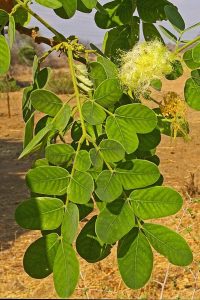
Albizia versicolor. Photo: Meg Coates Palgrave. Source: Flora of Zimbabwe
Albizia versicolor near the arboretum and garden. A path was slashed recently through undergrowth of Tithonia rotundifolia (Tango Daisy). No light penetrated this tall groundcover; the moist black vlei soil was seasonally inundated. A termite mound on the path was having additions to a ‘chimney’, soldiers guarded the opening, and about a dozen black and white leeches were near the top of the building. What goes on? Who knows the answer to this?
The birders agreed that they saw a juvenile European Hobby whilst leeches distracted a few of us, 40 bird species were identified.
Ant-galls on Acacia gerrardii on Katawa farm Raffingora.
The Flora Zambesiaca volume Ill Part 1 does not commit itself to explain the origin of ant-galls, whether they are outgrowths from the plant or caused by weevils. They are important in the classification of Acacias. See FZ p.105. Gall weevils have had a ball causing multiple galls piled up on each other making some branches end like knobkerries, numerous branches of Acacia gerrardii are heavily thickened with from crotch to tip. This tree with a graceful mien is gregarious, in the group some are partially afflicted and others are black monstrosities with hardly any space for foliage. One small twig less than 1cm diameter and 16cm long is all gall and weighs 400 gm.
African Wattle Design
A thing of beauty is the bark of Peltophorum africanum; it has a white and grey tweed appearance. The arrangement of lenticels on the young wood is the origin of the pattern. Have a look when you get the chance.
Butterflies.
Many stems of Maerua triphylla have grown up quickly through the security fence. Its delicate flowers attracted many butterflies in December. Often caterpillars defoliate this shrub. Would butterfly okes and lepidopterists such as Gareth Cornes and Marcus Jooste and the late Rob Pare agree that a butterfly on the wing is worth two on the pin?
Civetry
The civet middens near the house have been abandoned; they are checked often to see whether they are in use again. A typical heaped up civetry has become linear, 7 metres of smaller heaps on a low bank along the Council road from Chepstow to Mariwano. We rarely see the civets but we know what they have been eating, their diet now is well-digested mush, probably animal protein; figs galore, maize, a meal of tough vlei grass, now and then; and Diospyros lycioides – the star apple of which the calyx and smooth seeds are recognisable. On a round about route to the civetry there is a sapling of Burkea africana with bicoloured seeds of Tapinanthus attached to the bark on the sheltered side of its leaning stem.
Limpopo Safari Camp January 23rd to 26th 1998.
Sometime after lunch on the day of arrival our host invited us to cool off in the Limpopo with him, the stingless bees did not bother us, but the bed of the river got a bit hard after three quarters of an hour, it was cool when we stood up out of the nearly hot grey opaque water of the Great River which had a brisk current. During the upstream riverine forest walk, three metres of dead python stopped us in our tracks whilst we were rather afraid about our host who was without a weapon. What predators might we meet? Placidly watched by kudu made our fear depart. In the sand at the edge of the river there were small plants of Tree Tobacco, not in the least like Virginia tobacco; Lyn Mullin mentioned it in his studies on David Livingstone. Later at the Sentinel homestead the writer saw really tall woody specimens of Nicotiana glauca and masses of Sarcostemma viminale trailing over bushes at the top of a cliff overlooking the river. This was the view from the abandoned tennis court. These two plants have been known to poison cattle. The sandstone head, called the Sentinel, looks across the ranch towards the Limpopo; his countenance is dour.
The articulated skeleton of partially excavated Massospondylus draws a lot of people to Sentinel Ranch; there are other sites with dinosaur’s mineralised bones, near one of them. The writer thought she had found a different species of Tinnea not Tinnea rhodesiana.
To sum up, the whole scene in the southern lowveld away from the river was very xerophytic, plants showing every imaginable device to save water. Having said this, on the night of January 24/25, 62mm rain made the Ipazi rise in a black flood that cut everyone off from the bus route and us going to the homestead. What a wonderful difference the rain made, it was cooler. Whilst we were at the camp we saw the Limpopo rising steadily, huge suds of grubby foam were carried downstream in the swift current.
Here is something for the children.
Yes, trees can bark. They go bough-wough.
In 1944 Waddington’s Games Ltd. marketed packs of playing cards called Super Top Trumps. The topics are numerous; snakes, spiders, dinosaurs 1/2/3, exotic sports cars, frogs and toads, racing bikes, turbos and more. Close to my heart is the card of the foam-nest Tree Frog that gives the following details:
Length 55mm, Weight 25 gm, Adult lifespan 4 years.
There was one foam-nest above the water tank at the big house at Sentinel Ranch!
That’s all for now
Benedicta Graves
ANDY MacNAUGHTAN CHAIRMAN


